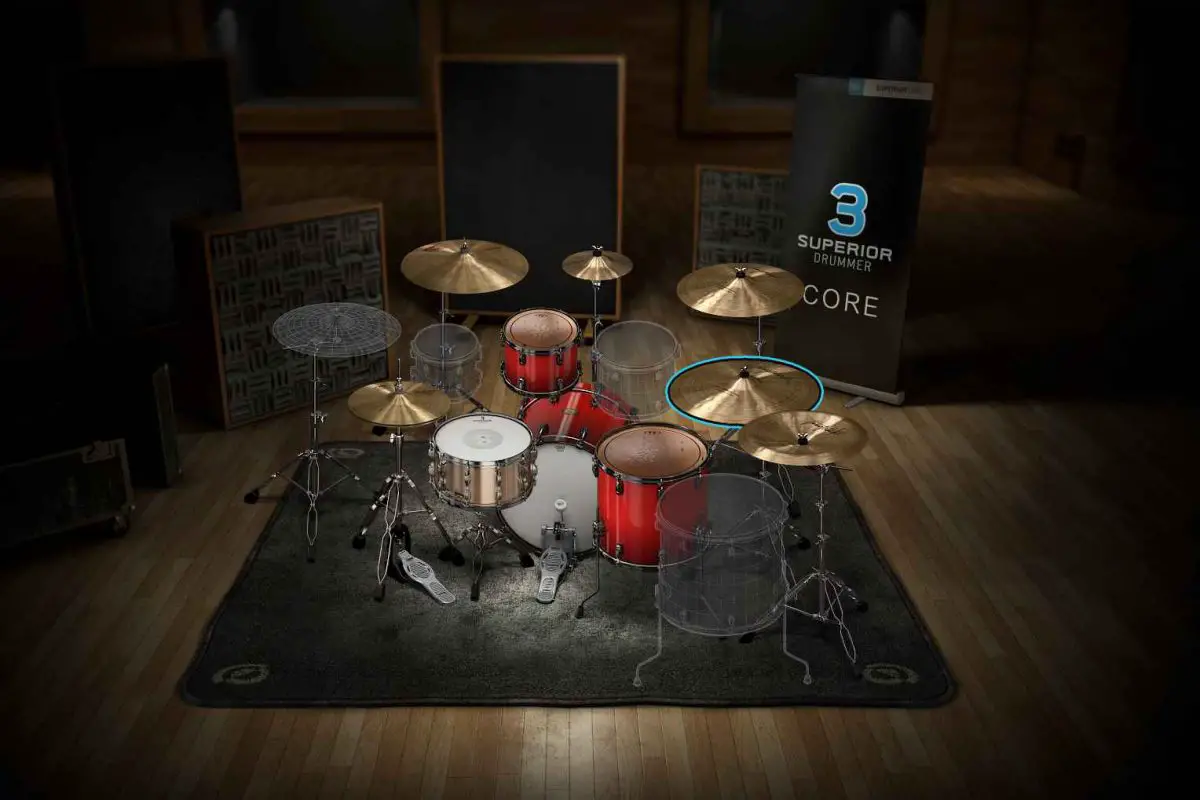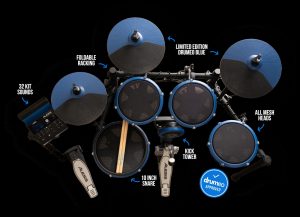While Superior Drummer 3 (SD3) is marketed as a tool for drum production, it can also work with your electronic drums, replacing your module sounds with professional quality drum samples by connecting your Mac or PC to your kit. Below, we’ll look at how to use Superior Drummer 3 with electronic drums, and why you might want to use this tool for eDrumming.
Pick up your copy of Superior Drummer 3 from Guitar Center or Thomann
Why might you want to use Superior Drummer 3 for drum triggering?
Superior Drummer 3 is a complete drum production tool, giving you access to drum samples recorded in a high-end studio, letting you edit and mix them to your heart’s content.
It sounds more true-to-life than even the best Roland electronic drums, and can even be triggered in real-time by your existing eDrum kit.
Each strike on the drum is sampled multiple times, with SD3 using a “round robin” system to rotate through each type of strike on a drum or cymbal. This means triggering drums via SD3 sounds highly realistic, as opposed to “single-shot” sampling, where the exact same drum hit is played over and over, resulting in a “machine gunning” effect.
When it comes to drum triggering, you have a huge amount of flexibility to edit the sounds to your preference.
For example, if you’re in a band and have used SD3 to record your latest album, you could load up the exact same drum kit preset on your practice kit as on your recording, and practice by playing along to your band’s music.
Or if you’re in a covers band, you can mix your drum sound to get close to the original drum mix used on the song you’re playing. If you use electronic drums live, that means you can make your performances sound even more authentic, similar to how a guitarist might adjust their amp settings to suit a certain song.
That flexibility also extends to the samples themselves, as you can adjust the pitch of drums and even cymbals with a very convincing AI algorithm.
In a nutshell, if you could benefit from this immense flexibility, then SD3 is a great option. But if you don’t need these advanced features and just want better drum sounds than your module’s onboard sound generator, then there are other options like EZdrummer or Steven Slate Drums and others which can be had for less money.
Do you need a DAW with Superior Drummer 3?
Superior Drummer 3 works both as a plugin inside a DAW (Digital Audio Workstation) or as a standalone application that you can launch directly within Mac or Windows.
If you’re looking to trigger Superior Drummer 3 with your eDrums and don’t need the recording functionality of a DAW, then triggering your eDrums within the standalone app is much simpler.
All the features of SD3 are the same regardless of whether you use it as a plugin or standalone. An additional benefit of using SD3 standalone for eDrummers, is that your computer won’t have to dedicate resources to running a DAW alongside SD3, which can help save RAM and benefit older computer users.
What computer do I need to use Superior Drummer 3 with eDrums?
Toontrack provides the system requirements on the Superior Drummer 3 product page.
But what else should you consider beyond the system requirements? Here are my tips for speccing a PC or Mac for use with SD3:
- Install your sound library to an SSD (Solid State Drive) for faster load times when you switch drum kits. If you don’t have an SSD, the drum sounds will play fine however, provided your computer meets the RAM requirements (8GB recommended)
- If you have a laptop with a small internal drive, you can install the sound library to an external drive (preferably an SSD). But remember to plug it in before you load up Superior Drummer!
- The Core sound library included with Superior Drummer 3 requires between 41GB for a basic install and up to 236GB. Choose the basic install if all you’re doing is triggering your eDrums. All the full install adds is support for surround sound and extra room mics, which you don’t need and makes no difference to sound quality
- There are plenty of other expansion packs (known as SDX packs) that include other drum kits. Just remember you’ll need room on your drive for these too if you buy them!
SD3 can take up a fair bit of storage space, so consider if you need to buy an additional internal SSD if you have a desktop, or external SSD if you use a laptop.
How to set up your eDrums with Superior Drummer 3
Setting up SD3 with electronic drums is simple:
Ensure SD3 is installed
SD3 is installed via Toontrack Product Manager. Ensure the application itself is installed and that your sound library is downloaded.
Connect your drums to your PC
If your drum module has a USB interface, then plug it into your PC or Mac, having downloaded and installed the drivers first. Driver software can be found on your eDrum manufacturer’s website.
If your drum kit only has a MIDI interface, you’ll need an external MIDI or Audio & MIDI USB interface between your drums and computer.
Set a small buffer size for low latency
If your eDrum driver or audio interface software allows it, set a small buffer size. This helps to ensure there is no audible latency between hitting a drum and hearing the sound sample. Generally, Macs tend to perform better in terms of latency, whereas older Windows devices might be more susceptible to latency.
Turn off your drum module’s internal sounds
Next, turn off your module’s internal sounds. This is a must if you’re outputting through your module’s headphones or master out, as you don’t want the module sounds to come through alongside the Superior Drummer sounds. Even if you’re not using your module as the output device, turning this off can help to improve latency.
On a Roland module, this toggle is called ‘Local Control’ and can be found under the MIDI settings in the module interface.

Select the audio device on your computer and in Superior Drummer 3
In SD3, go to Audio/MIDI Set up.
First, go to the MIDI Device tab and make sure your module or audio interface is selected and hit apply. This is to ensure the MIDI signals sent from your pads and module reach SD3.
Next, go to the Audio Device tab to set where the audio output should go. In my case, I want the audio to output via my module’s headphones, so I’ve selected my drum module here.
You can also see information about latency here, which relates to the buffer size and latency settings you adjusted earlier. Generally, a latency of under 10 ms is acceptable.
More powerful hardware can help you achieve lower latency. My PC is pretty high spec and achieves a latency of 3.2ms, whereas my 2013 MacBook Pro would get around 5-6ms latency. But because both are under 10ms, to the human ear there is no difference.
If you want to play along to songs from Spotify, Apple Music, or other applications, then be sure to set your drum module or audio interface as the output device for your PC or Mac as well.
Alternatively, if you’re using your eDrums to play live, you can set your system output to a different audio device. That ensures no unwanted sounds are output through your module.
Set MIDI device in Superior Drummer
Next, in SD3 go to MIDI In/E-Drums.
This is where you can set up your pads to trigger the correct drums and cymbals from SD3. The software includes a wide range of presets for many popular drum modules, so as a starting point, chose the preset that corresponds with your module.
Test your set-up
Test your preset by playing the drums, making sure drums are triggering and that you can hear the sound output. If anything isn’t working correctly, look at the drums on screen as you hit your eDrums – the on-screen heads and cymbals will light up when struck.
If they don’t light up, check your MIDI settings. If they do light up but you don’t hear anything, check the audio settings in Superior Drummer and on your PC, and make sure your speakers or headphones are plugged in and turned up.
Remap any pads in MIDI settings and save a preset for your kit
You might need to remap some pads to get the instruments you want to play, especially since most electronic drums don’t have the same number of pad inputs as are available within SD3.
Reenter the MIDI In/E-Drums screen in SD3 and in the left hand choose the instrument you want to remap. On the right-hand side, pick the articulation (e.g. bow/edge on a cymbal or head/rim on a drum), then click on the ‘learn’ button, and strike the pad you want to assign that articulation to.

Repeat this with any other sounds you want to remap. Once complete, you can save a custom preset using the settings you’ve just assigned, so you don’t need to continually re-enter the settings each time you load SD3.
Save everything as a Project
You can save all your settings including MIDI preset, audio settings, and drum kit settings to a project, which massively speeds up loading everything in when you want to practice on your eDrums.
Go to File and click on Save As.
Next time you want to play the drums, you can simply turn on your eDrums (while connected to your computer), and then open this file, then all your settings will return.
I typically use a Project file per SD3 drum library, and then if I want to change my drum sounds, I’ll go to the kit settings within that project and choose a kit preset.
FAQs
Does Superior Drummer sound better than EZdrummer?
EZdrummer is basically a scaled-down and simplified version of Superior Drummer. While it is mainly marketed toward songwriters, it can also be used for drum triggering. The differences are that EZdrummer offers less customisation of drum sounds by being reliant on using various presets, which are actually based on the recordings used for Superior Drummer and its expansion packs.
The difference, therefore, is that Superior Drummer 3 has a lot more flexibility, you can actually create your own drum sounds with a built-in multi-channel mixer, dialling in room reverb via the mics, and adding EQ or other effects. You can even go the complete opposite way by using the raw drum sample recordings with no effects at all.
So to sum up, the difference isn’t that Superior Drummer sounds better, it’s all about the flexibility that SD3 offers over EZdrummer. Read more about if Superior Drummer is better than EZdrummer here.
If you already have EZdrummer 2 but want to switch to Superior Drummer 3, you can get a crossgrade license at a discounted price from Guitar Center.
You can also check out our detailed EZdrummer 3 review to help you decide if Toontrack’s entry-level platform offers the features you need. Alternatively, find out how to connect EZdrummer 3 to your eDrums.
Wrapping Up
SD3 is one of the most fully featured drum libraries out there, but while powerful, it’s easy to set up and use for drum triggering. If you’re just getting into eDrumming with VST instruments, you can check out our guide on the best modules for VST drum libraries, or if you want to compare alternatives to VST drum libraries, try our article on how to make your electronic drums sound real.
This article contains affiliate links. If you purchase a product through certain links on our site, we may earn a small affiliate commission. Learn more about our adverts and why you can trust eDrumHub here.




